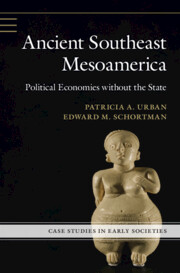Book contents
- Ancient Southeast Mesoamerica
- Case Studies in Early Societies
- Ancient Southeast Mesoamerica
- Copyright page
- Dedication
- Contents
- Figures
- Acknowledgments
- 1 Ways of Understanding Southeast Mesoamerica
- 2 Power, Hierarchy, and Social Differentiation
- 3 Early Arrivals, Domestication, and Emerging Sociopolitical Complexity in Southeast Mesoamerica (10,000 (?)–400 BCE)
- 4 Reformulating Social Networks through the Novel Uses of Things (400 BCE–CE 200)
- 5 The Arrival of Divine Lords
- 6 The Copán Realm, Its Colonies and Allies (CE 600–800)
- 7 The End of Days
- 8 Concentrating Power and Building Hierarchy beyond the Copán-Centered Network (CE 600–800)
- 9 Concentrating Power in the Terminal Classic beyond Copán (CE 800–1000)
- 10 Power and Political Economy in the Late Classic Naco and Middle Chamelecón Valleys (CE 600–800)
- 11 Hierarchy to Heterarchy in the Terminal Classic Naco and Middle Chamelecón Valleys (CE 800–1000)
- 12 Contrasting Forms of Complexity
- 13 Contesting for Power, Challenging Hierarchy, Making History
- References
- Index
4 - Reformulating Social Networks through the Novel Uses of Things (400 BCE–CE 200)
Published online by Cambridge University Press: 02 April 2024
- Ancient Southeast Mesoamerica
- Case Studies in Early Societies
- Ancient Southeast Mesoamerica
- Copyright page
- Dedication
- Contents
- Figures
- Acknowledgments
- 1 Ways of Understanding Southeast Mesoamerica
- 2 Power, Hierarchy, and Social Differentiation
- 3 Early Arrivals, Domestication, and Emerging Sociopolitical Complexity in Southeast Mesoamerica (10,000 (?)–400 BCE)
- 4 Reformulating Social Networks through the Novel Uses of Things (400 BCE–CE 200)
- 5 The Arrival of Divine Lords
- 6 The Copán Realm, Its Colonies and Allies (CE 600–800)
- 7 The End of Days
- 8 Concentrating Power and Building Hierarchy beyond the Copán-Centered Network (CE 600–800)
- 9 Concentrating Power in the Terminal Classic beyond Copán (CE 800–1000)
- 10 Power and Political Economy in the Late Classic Naco and Middle Chamelecón Valleys (CE 600–800)
- 11 Hierarchy to Heterarchy in the Terminal Classic Naco and Middle Chamelecón Valleys (CE 800–1000)
- 12 Contrasting Forms of Complexity
- 13 Contesting for Power, Challenging Hierarchy, Making History
- References
- Index
Summary
In this chapter, we consider how power was centralized within multiple Southeastern societies and the ways such pretensions were challenged. These contests were waged as people employed a diverse array of things secured from various sources to accomplish their distinct aims. Efforts to concentrate power and build hierarchies generally involved the creation of plazas, surrounded by monumental platforms, that served as venues for communal gatherings. The rituals and feasts held within these locales helped instill in the participants a sense of belonging to a group that encompassed and transcended earlier loyalties to individual households. Such events also promoted the preeminence of those who hosted them, planned the raising of these impressive arenas, and lived in the buildings bordering them. Resistance to these political projects relied on the majority’s efforts to remain economically self-sufficient, thus stymieing the emergence of hierarchies in most parts of the Southeast. The resulting political formations varied in their degrees of power concentration and the creation of invidious distinctions based on the shifting outcomes of these power competitions.
- Type
- Chapter
- Information
- Ancient Southeast MesoamericaPolitical Economies without the State, pp. 79 - 104Publisher: Cambridge University PressPrint publication year: 2024



